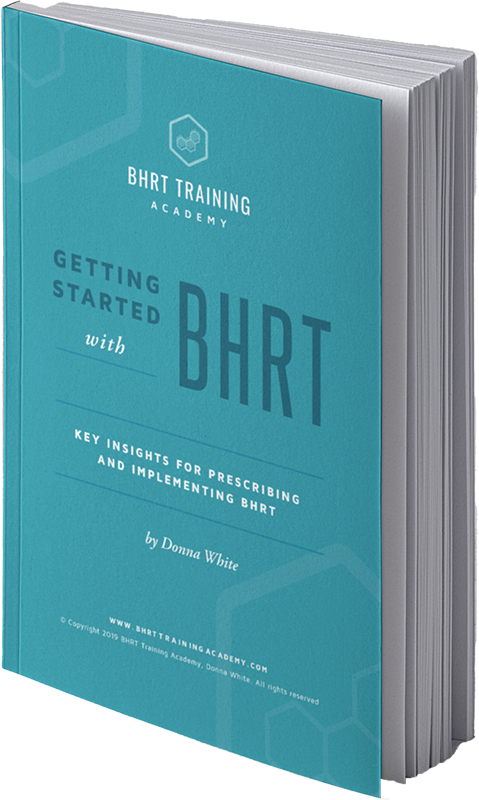How to Diagnose and Treat Low Testosterone In Males

Low testosterone in males (also generally referred to as andropause or hypogonadism) is a common problem for men over 40.
Health practitioners looking to treat low androgens with BHRT should have a clear understanding of diagnoses and treatment for effective results.
The Role of Testosterone in Males
Testosterone is a steroid hormone from the androgen group and is secreted primarily by the testicles, although small amounts are also made by the adrenal glands.
It is the principal male sex hormone and an anabolic steroid. A normal level of testosterone in the body helps to:
- Increase sexual interest
- Increase sense of emotional well being
- Reduce anxiety and depression
- Increase muscle mass and strength
- Maintain memory
- Prevent skin from sagging
- Decrease excess body fat
- Maintain bone strength
- Increase hepatic synthesis of clotting factors
- Increase bone mineral density
- Increase HDL
- Increase erythropoietin synthesis
- Increase anabolic function
- Improve arterial dilation
- Augment cardiac output
- Has anti-inflammatory activities
Testosterone replacement therapy can offer support in these areas when testosterone levels drop.
5 Health Problems Associated with Low Testosterone in Males
Men make around 5 to 10mg of testosterone daily, and testosterone levels decline 1-1.5% per year after age thirty.
By age 60, testosterone levels may only be 60% of the amount made during their 20’s.
Low testosterone (total testosterone less than 300 ng/dl) is as high as 38.7% in males over 45 years of age in out-patient primary care populations.
There are many health problems that can be attributed (at least in part) to lower than normal testosterone levels, including an overall increase in mortality.
The most common health symptoms associated with low testosterone in males are as follows.
1. Changes in Mood and Energy
Low testosterone in males may manifest itself in signs related to low energy, sleep disturbance, fatigue, and/or depression.
2. Loss of Sex Drive
One of the most common signs of low testosterone in males is related to a decrease in sex drive and erectile dysfunction.
Interestingly, some men do maintain their sex drive despite testosterone deficiency. Therefore, many men with low testosterone go undiagnosed assuming their level must be normal.
3. Problems with Muscles and Bones
Osteoporosis and muscle wasting are two signs that testosterone may be low. These ailments are typically indicated by symptoms such as low bone density, lack of flexibility and low strength.
Osteoarthritis and related inflammation are common results of muscle and bone problems.
4. Metabolic Changes
Low testosterone typically is associated with a general slowing of metabolism. This may manifest in excess abdominal fat, obesity, and insulin resistance.
5. Cardiovascular Illnesses
Heart disease and stroke are common in men over 50. Testosterone treatment may help to reduce the risk of cardiovascular problems in older men.
Diagnosing Low Testosterone in Males
Primary or secondary hypogonadism is typically the issue if a patient is over 40 and their symptoms include those discussed above, along with:
- A positive ADAM Score
- Low or Suboptimal Testosterone <500
- Low or Suboptimal Free Testosterone
The ADAM Score (Androgen Deficiency in Aging Males) is typically used to quantify the severity of hypogonadism, where a positive result is defined as “yes” to questions 1 or 7 or any 3 others. (Int J Impot Res)
Here are the ADAM Score questions:
1. Do you have a decrease in libido (sex drive)?
2. Do you have a lack of energy?
3. Do you have a decrease in strength and/or endurance?
4. Have you lost height?
5. Have you noticed a decreased “enjoyment of life”
6. Are you sad and/or grumpy?
7. Are your erections less strong?
8. Have you noticed a recent deterioration in your ability to play sports?
9. Are you falling asleep after dinner?
10. Has there been a recent deterioration in your work performance?
Treating Low Testosterone in Males
Hypogonadism is typically caused by one of these things:
- The testes do not produce enough testosterone (primary or secondary hypogonadism)
- Improper brain signaling
- Excess estrogen
The treatments discussed below primarily focus on hypogonadism. Health practitioners should note that secondary hypogonadism may require HCG as a treatment
Lifestyle improvements are almost always a factor in hypogonadism and so should be included in any treatment plan as a relevant treatment to specific symptoms.
Testosterone Supplementation
This is the most common type of treatment and is often the first choice for men. It’s shown to be effective and generally has very little in the way of side effects.
The treatment plan should include:
- Lab evaluation for free and total testosterone, SHBG. LH, estradiol, DHEA’s, CBC, LFT’s, PSA
- Monitoring estrogen levels
- Watching for polycythemia
- Using HCG in conjunction with testosterone in some cases
Testosterone Administration and Dosage
Typically injections are the most common administration format for testosterone.
The most important point for practitioners here is that more frequent injections at lower doses are preferable to higher doses at less frequent intervals. The recommended dose is 75mg to 100mg every 7-10 days.
Another option for testosterone replacement therapy is topical administration. Formats include creams, lotions, and gels at a dose of 40mg to 120mg daily.
Finally, testosterone pellet implantation is becoming increasingly popular and offers similar results as injections. Pellets may last 4-6 months. A typical starting dose is 1000-1200mg.
Discover the Benefits of Bioidentical Hormone Replacement Therapy
BHRT can help treat both men and women who are struggling with symptoms of age-related hormone deficiencies.
To learn more about this life-changing treatment, book a consultation.
Enjoyed this article? Here are three more to help you:
Menopause and BHRT: What’s the Best Type of Treatment?
Four Common Types of Hormonal Imbalance – Perimenopause/PMS
How BHRT Can Help Patients Ease the Symptoms of Aging

Get the quick read ebook,
Getting Started with BHRT -
Key Insights to Prescribing and Implementing BHRT.
CME's - Earn while you learn.
